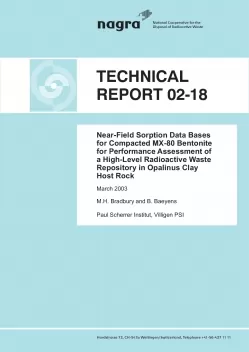
Technical Report NTB 02-18
Near-Field Sorption Data Bases for Compacted MX-80 Bentonite for Performance Assessment of a High-Level Radioactive Waste Repository in Opalinus Clay Host Rock
Bentonites of various types and compacted forms are being investigated in many countries as backfill materials in high-level radioactive waste disposal concepts. Nagra is currently considering an Opalinus clay (OPA) formation in the Zürcher Weinland as a potential location for a high-level radioactive waste repository. A compacted MX-80 bentonite is foreseen as a potential backfill material. Performance assessment studies will be performed for this site and one of the requirements for such an assessment are sorption data bases (SDB) for the bentonite near-field. The purpose of this report is to describe the procedures used to develop the SDB.
One of the pre-requisites for developing a SDB is a water chemistry for the compacted bentonite porewater. For a number of reasons mentioned in the report, and discussed in more detail elsewhere, this is not a straightforward task. There are considerable uncertainties associated with the major ion concentrations and in particular with the system pH and Eh. The MX-80 SDB was developed for a reference bentonite porewater (pH = 7.25) which was calculated using the reference OPA porewater. In addition, two further SDBs are presented for porewaters calculated at pH value of 6.9 and 7.9 corresponding to lower and upper bound values calculated for the range of groundwater compositions anticipated for the OPA host rock.
"In house" sorption isotherm data were measured for Cs(I), Ni(II), Eu(III), Th(IV), Se(lV) and I(-I) on the "as received" MX-80 material equilibrated with a simulated porewater composition. Complementary "in house" sorption edge and isotherm measurements on conditioned Na/Ca montmorillonites were also available for many of these radionuclides. These data formed the core of the SDB. Nevertheless, some of the required sorption data still had to be obtained from the open literature. An important part of this report is concerned with describing selection procedures and the modifications applied to the chosen values so that they are compatible with the reference mineralogy and porewater chemistries.
The SDB comprises of distribution ratios (Rd) obtained from batch sorption type measurements made on dispersed systems. It is not intrinsically evident that these values are valid for compacted systems as required in the performance assessment. Arguments justifying this Lab to Field transformation are presented in a separate report and the main conclusions are summarised here.
Finally, an attempt is made to assess the uncertainties associated with the selected distribution ratios in the SDB.
Nagra is considering a scenario where oxidising conditions exist in the near-field of the compacted bentonite surrounding spent fuel. In such a case the MX-80 porewater is considered to have the same composition as that in the reference case (pH = 7.25), but with a redox potential (Eh) of +635 mV. Tc, Se, U, Np and Pu have been identified as the only safety relevant radionuclides which will have redox states different from those in the reference reducing case. Sorption values for the above radionuclides are presented in the Appendix.
